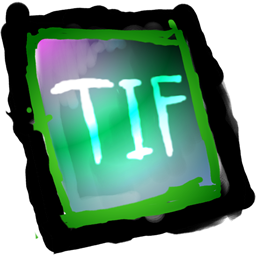| |
|
TIFF (Tagged) Image Format
Format name: Tagged Image File Format
File extension: .tif, .tiff
 TIFF
(initially, an abbreviation from "Tagged Image File Format") is one of the most
complex formats, difficult for recoding and rendering images. Each
T.I.F.F. file begins with an 8-byte image file header (IFH), whose most
important element, the image file directory (IFD), indicates the data structure.
IFD is a table for identifying one or more variable-width data portions ("tags")
that store information about the image. The TIF specification defines more than
70 different tags. For example, tag one may store information about the image
width (in pixels); tag two, information about the image height; tag three, the
color table (if used); and tag four, bitmap array data. An image stored in a
T.I.F.F. file can be fully defined by its tags. The format is easily extensible as
all you need to do to add new properties to the file is define new tags. TIFF
(initially, an abbreviation from "Tagged Image File Format") is one of the most
complex formats, difficult for recoding and rendering images. Each
T.I.F.F. file begins with an 8-byte image file header (IFH), whose most
important element, the image file directory (IFD), indicates the data structure.
IFD is a table for identifying one or more variable-width data portions ("tags")
that store information about the image. The TIF specification defines more than
70 different tags. For example, tag one may store information about the image
width (in pixels); tag two, information about the image height; tag three, the
color table (if used); and tag four, bitmap array data. An image stored in a
T.I.F.F. file can be fully defined by its tags. The format is easily extensible as
all you need to do to add new properties to the file is define new tags.
What makes T.I.F.F. format so complex? First, it's not so easy to develop
software that can recognize all tags. Most T.I.F.F. viewers implement only a subset
of tags, so a TIF file created by one application sometimes cannot be read by
another. Besides, some TIFF-making applications can define their own tags, which
may be utterly meaningless for other software. T.I.F.F. viewers usually skip tags
they cannot recognize, though sometimes that may result in the image being
rendered incorrectly.
Yet another difficulty is that a T.I.F.F. file may contain multiple images, each of
them with its own IFD and set of tags. Bitmap array data may be compressed using
any of a number of methods, so a good image viewer must be able to uncompress RLE,
LZW, and some other formats. Until several years ago, the situation was worsened
by the fact that any use of the LZW algorithm had to be licensed from Unisys
Corporation, often for a fee. (Thankfully, the patents for LZW expired in 2003.)
As a result, even the best image viewers sometimes fail to read some T.I.F.F. files.
Despite its complexity, T.I.F.F. is still one of the most portable formats for
passing bitmap arrays from one platform to another. The universality of T.I.F.F.
means that almost any image can be encoded without losing its visual or any
other attributes. |
|
|